Financial Resource Management and Decisions: A Detailed Report
VerifiedAdded on 2020/01/23
|19
|5695
|43
Report
AI Summary
This report delves into the critical aspects of financial resource management and decision-making for a new business venture. It begins by identifying various funding sources such as crowdfunding, business angels, venture capital, government programs, loans, and family/relatives. The report then evaluates the pros and cons of each source, considering factors like legal implications, investor involvement, and return on investment. The entrepreneur is guided to select the most cost-effective source, with angel financing recommended over venture capital due to lower associated costs. The report further analyzes the costs associated with each funding option, including opportunity costs, interest rates, and equity dilution. A strong emphasis is placed on the importance of financial planning to ensure sufficient funds, timely investments, efficient resource allocation, and the ability to adapt to market changes. The report includes cash budget analysis, unit cost calculations, and ratio analysis of a company to illustrate financial planning in action. The analysis extends to capital budgeting decisions, with calculations of Net Present Value (NPV), Internal Rate of Return (IRR), and payback period to assess project viability and make informed investment choices. The report provides a comprehensive guide to financial management for new businesses, aiding entrepreneurs in making well-informed decisions.

Managing Financial
Resources and
Decisions
Resources and
Decisions
Paraphrase This Document
Need a fresh take? Get an instant paraphrase of this document with our AI Paraphraser
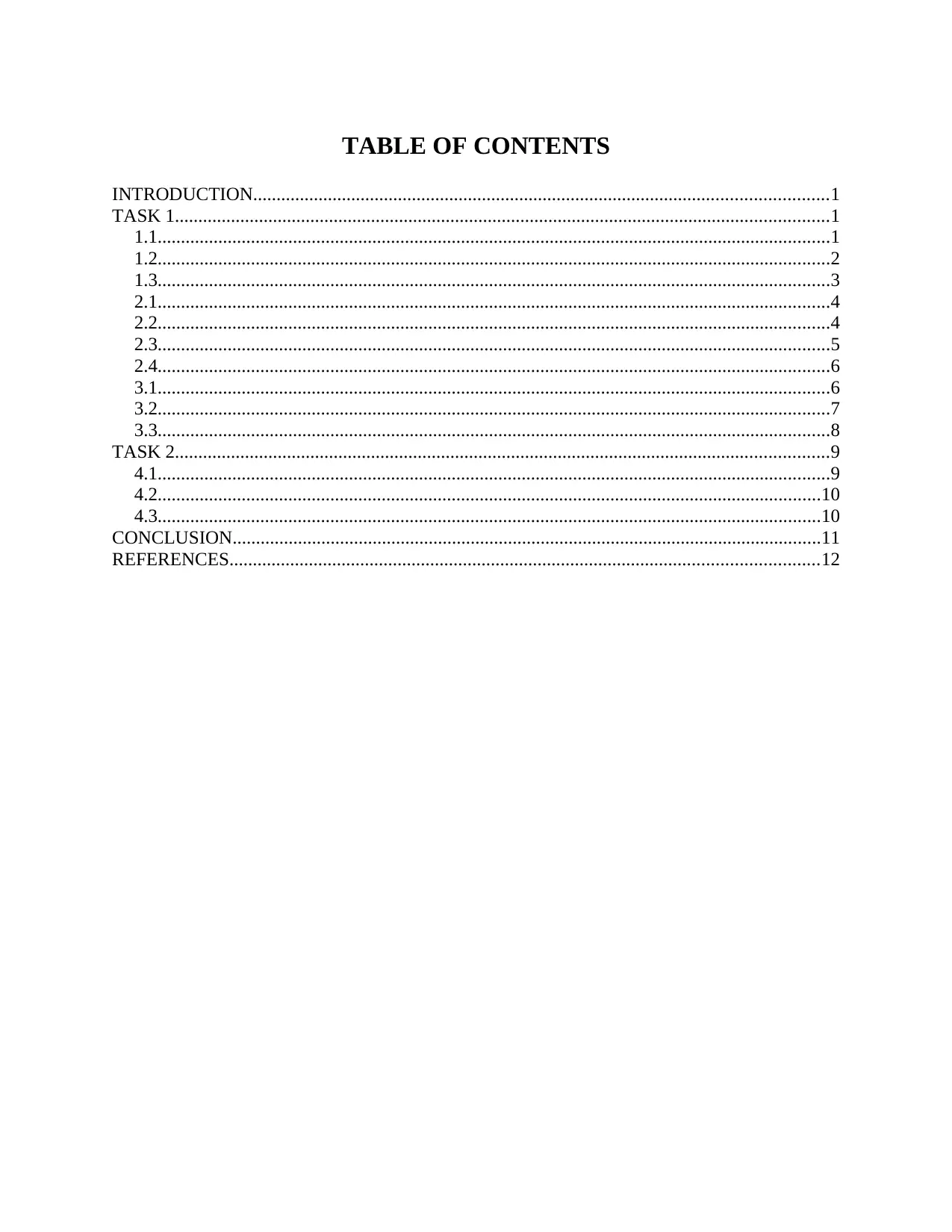
TABLE OF CONTENTS
INTRODUCTION...........................................................................................................................1
TASK 1............................................................................................................................................1
1.1................................................................................................................................................1
1.2................................................................................................................................................2
1.3................................................................................................................................................3
2.1................................................................................................................................................4
2.2................................................................................................................................................4
2.3................................................................................................................................................5
2.4................................................................................................................................................6
3.1................................................................................................................................................6
3.2................................................................................................................................................7
3.3................................................................................................................................................8
TASK 2............................................................................................................................................9
4.1................................................................................................................................................9
4.2..............................................................................................................................................10
4.3..............................................................................................................................................10
CONCLUSION..............................................................................................................................11
REFERENCES..............................................................................................................................12
INTRODUCTION...........................................................................................................................1
TASK 1............................................................................................................................................1
1.1................................................................................................................................................1
1.2................................................................................................................................................2
1.3................................................................................................................................................3
2.1................................................................................................................................................4
2.2................................................................................................................................................4
2.3................................................................................................................................................5
2.4................................................................................................................................................6
3.1................................................................................................................................................6
3.2................................................................................................................................................7
3.3................................................................................................................................................8
TASK 2............................................................................................................................................9
4.1................................................................................................................................................9
4.2..............................................................................................................................................10
4.3..............................................................................................................................................10
CONCLUSION..............................................................................................................................11
REFERENCES..............................................................................................................................12
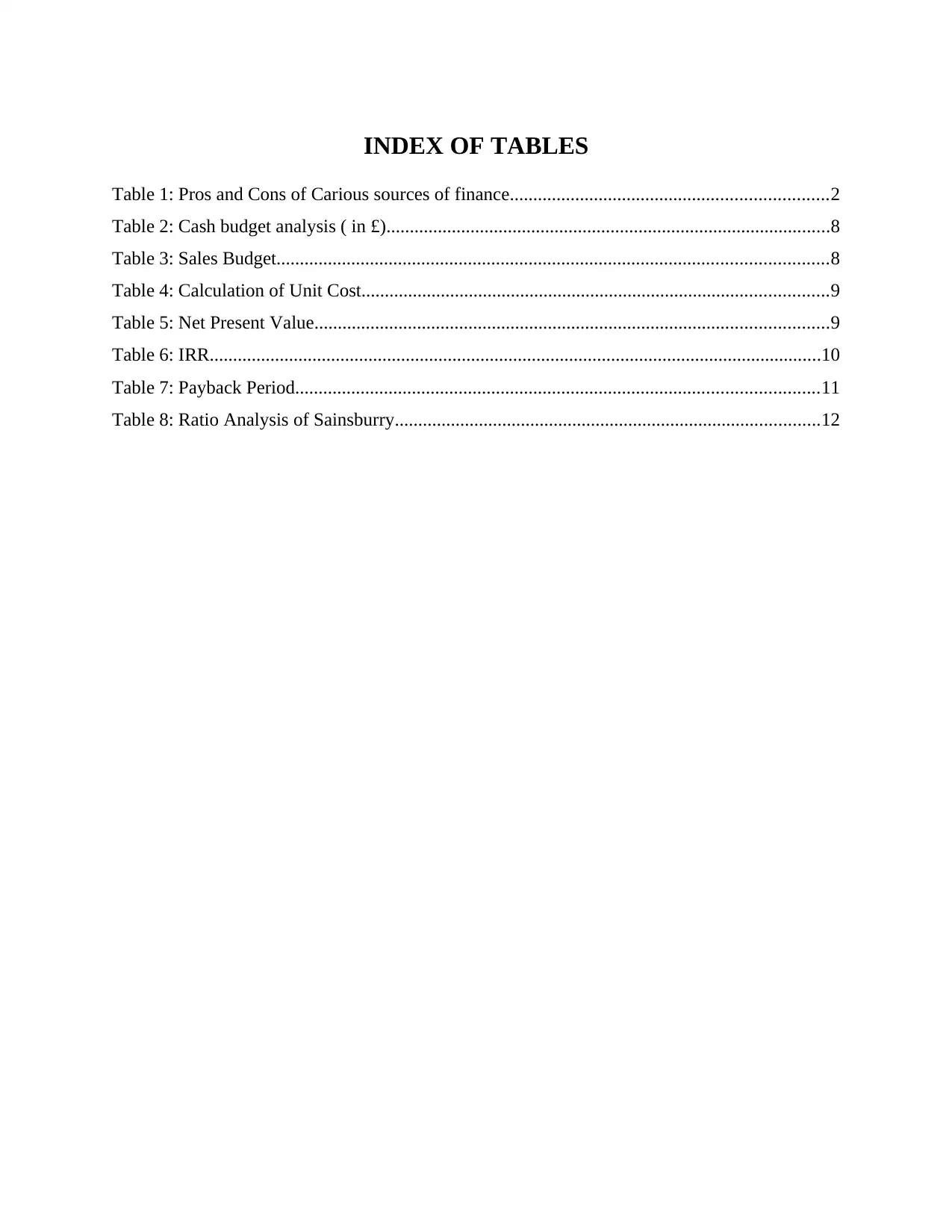
INDEX OF TABLES
Table 1: Pros and Cons of Carious sources of finance....................................................................2
Table 2: Cash budget analysis ( in £)...............................................................................................8
Table 3: Sales Budget......................................................................................................................8
Table 4: Calculation of Unit Cost....................................................................................................9
Table 5: Net Present Value..............................................................................................................9
Table 6: IRR...................................................................................................................................10
Table 7: Payback Period................................................................................................................11
Table 8: Ratio Analysis of Sainsburry...........................................................................................12
Table 1: Pros and Cons of Carious sources of finance....................................................................2
Table 2: Cash budget analysis ( in £)...............................................................................................8
Table 3: Sales Budget......................................................................................................................8
Table 4: Calculation of Unit Cost....................................................................................................9
Table 5: Net Present Value..............................................................................................................9
Table 6: IRR...................................................................................................................................10
Table 7: Payback Period................................................................................................................11
Table 8: Ratio Analysis of Sainsburry...........................................................................................12
⊘ This is a preview!⊘
Do you want full access?
Subscribe today to unlock all pages.

Trusted by 1+ million students worldwide
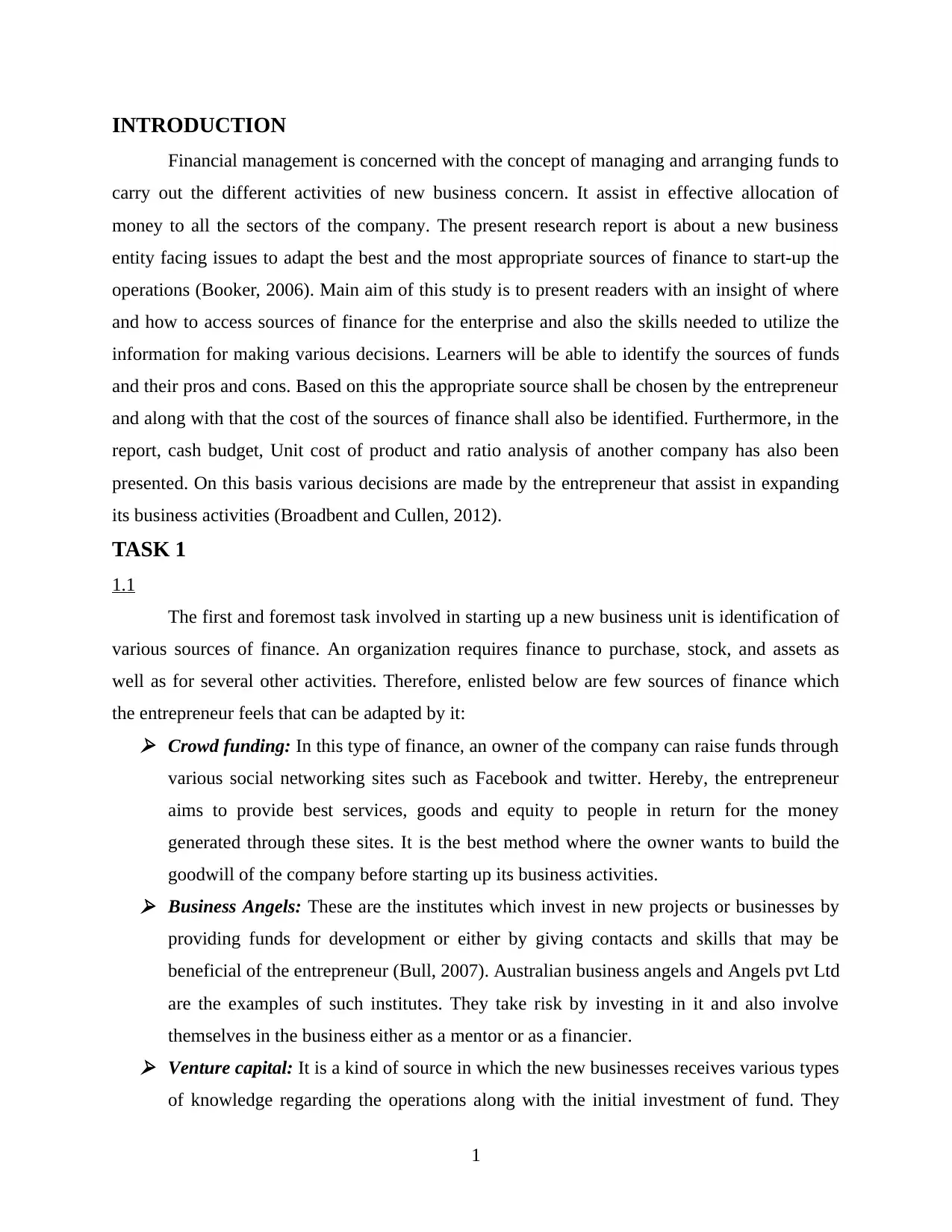
INTRODUCTION
Financial management is concerned with the concept of managing and arranging funds to
carry out the different activities of new business concern. It assist in effective allocation of
money to all the sectors of the company. The present research report is about a new business
entity facing issues to adapt the best and the most appropriate sources of finance to start-up the
operations (Booker, 2006). Main aim of this study is to present readers with an insight of where
and how to access sources of finance for the enterprise and also the skills needed to utilize the
information for making various decisions. Learners will be able to identify the sources of funds
and their pros and cons. Based on this the appropriate source shall be chosen by the entrepreneur
and along with that the cost of the sources of finance shall also be identified. Furthermore, in the
report, cash budget, Unit cost of product and ratio analysis of another company has also been
presented. On this basis various decisions are made by the entrepreneur that assist in expanding
its business activities (Broadbent and Cullen, 2012).
TASK 1
1.1
The first and foremost task involved in starting up a new business unit is identification of
various sources of finance. An organization requires finance to purchase, stock, and assets as
well as for several other activities. Therefore, enlisted below are few sources of finance which
the entrepreneur feels that can be adapted by it: Crowd funding: In this type of finance, an owner of the company can raise funds through
various social networking sites such as Facebook and twitter. Hereby, the entrepreneur
aims to provide best services, goods and equity to people in return for the money
generated through these sites. It is the best method where the owner wants to build the
goodwill of the company before starting up its business activities. Business Angels: These are the institutes which invest in new projects or businesses by
providing funds for development or either by giving contacts and skills that may be
beneficial of the entrepreneur (Bull, 2007). Australian business angels and Angels pvt Ltd
are the examples of such institutes. They take risk by investing in it and also involve
themselves in the business either as a mentor or as a financier. Venture capital: It is a kind of source in which the new businesses receives various types
of knowledge regarding the operations along with the initial investment of fund. They
1
Financial management is concerned with the concept of managing and arranging funds to
carry out the different activities of new business concern. It assist in effective allocation of
money to all the sectors of the company. The present research report is about a new business
entity facing issues to adapt the best and the most appropriate sources of finance to start-up the
operations (Booker, 2006). Main aim of this study is to present readers with an insight of where
and how to access sources of finance for the enterprise and also the skills needed to utilize the
information for making various decisions. Learners will be able to identify the sources of funds
and their pros and cons. Based on this the appropriate source shall be chosen by the entrepreneur
and along with that the cost of the sources of finance shall also be identified. Furthermore, in the
report, cash budget, Unit cost of product and ratio analysis of another company has also been
presented. On this basis various decisions are made by the entrepreneur that assist in expanding
its business activities (Broadbent and Cullen, 2012).
TASK 1
1.1
The first and foremost task involved in starting up a new business unit is identification of
various sources of finance. An organization requires finance to purchase, stock, and assets as
well as for several other activities. Therefore, enlisted below are few sources of finance which
the entrepreneur feels that can be adapted by it: Crowd funding: In this type of finance, an owner of the company can raise funds through
various social networking sites such as Facebook and twitter. Hereby, the entrepreneur
aims to provide best services, goods and equity to people in return for the money
generated through these sites. It is the best method where the owner wants to build the
goodwill of the company before starting up its business activities. Business Angels: These are the institutes which invest in new projects or businesses by
providing funds for development or either by giving contacts and skills that may be
beneficial of the entrepreneur (Bull, 2007). Australian business angels and Angels pvt Ltd
are the examples of such institutes. They take risk by investing in it and also involve
themselves in the business either as a mentor or as a financier. Venture capital: It is a kind of source in which the new businesses receives various types
of knowledge regarding the operations along with the initial investment of fund. They
1
Paraphrase This Document
Need a fresh take? Get an instant paraphrase of this document with our AI Paraphraser
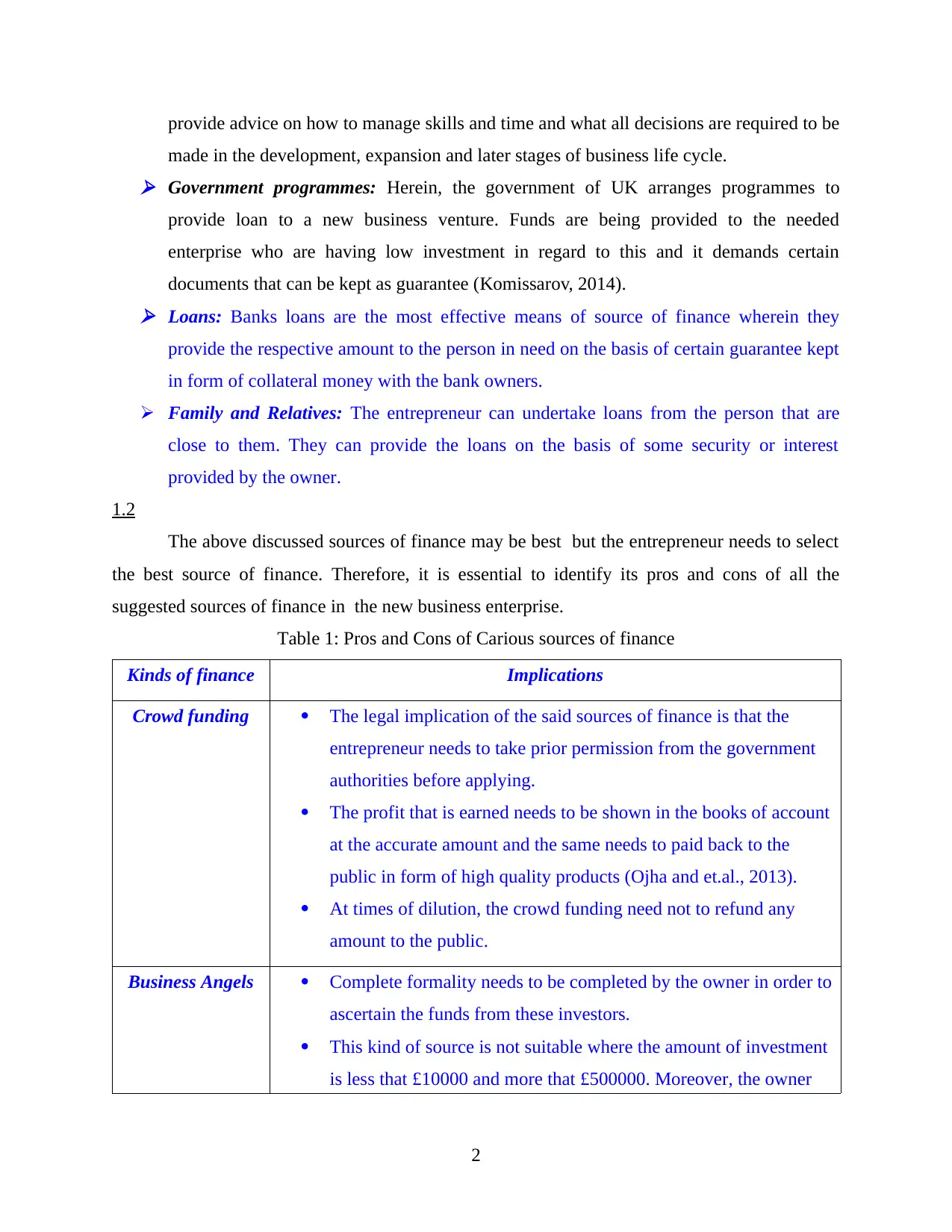
provide advice on how to manage skills and time and what all decisions are required to be
made in the development, expansion and later stages of business life cycle. Government programmes: Herein, the government of UK arranges programmes to
provide loan to a new business venture. Funds are being provided to the needed
enterprise who are having low investment in regard to this and it demands certain
documents that can be kept as guarantee (Komissarov, 2014). Loans: Banks loans are the most effective means of source of finance wherein they
provide the respective amount to the person in need on the basis of certain guarantee kept
in form of collateral money with the bank owners.
Family and Relatives: The entrepreneur can undertake loans from the person that are
close to them. They can provide the loans on the basis of some security or interest
provided by the owner.
1.2
The above discussed sources of finance may be best but the entrepreneur needs to select
the best source of finance. Therefore, it is essential to identify its pros and cons of all the
suggested sources of finance in the new business enterprise.
Table 1: Pros and Cons of Carious sources of finance
Kinds of finance Implications
Crowd funding The legal implication of the said sources of finance is that the
entrepreneur needs to take prior permission from the government
authorities before applying.
The profit that is earned needs to be shown in the books of account
at the accurate amount and the same needs to paid back to the
public in form of high quality products (Ojha and et.al., 2013).
At times of dilution, the crowd funding need not to refund any
amount to the public.
Business Angels Complete formality needs to be completed by the owner in order to
ascertain the funds from these investors.
This kind of source is not suitable where the amount of investment
is less that £10000 and more that £500000. Moreover, the owner
2
made in the development, expansion and later stages of business life cycle. Government programmes: Herein, the government of UK arranges programmes to
provide loan to a new business venture. Funds are being provided to the needed
enterprise who are having low investment in regard to this and it demands certain
documents that can be kept as guarantee (Komissarov, 2014). Loans: Banks loans are the most effective means of source of finance wherein they
provide the respective amount to the person in need on the basis of certain guarantee kept
in form of collateral money with the bank owners.
Family and Relatives: The entrepreneur can undertake loans from the person that are
close to them. They can provide the loans on the basis of some security or interest
provided by the owner.
1.2
The above discussed sources of finance may be best but the entrepreneur needs to select
the best source of finance. Therefore, it is essential to identify its pros and cons of all the
suggested sources of finance in the new business enterprise.
Table 1: Pros and Cons of Carious sources of finance
Kinds of finance Implications
Crowd funding The legal implication of the said sources of finance is that the
entrepreneur needs to take prior permission from the government
authorities before applying.
The profit that is earned needs to be shown in the books of account
at the accurate amount and the same needs to paid back to the
public in form of high quality products (Ojha and et.al., 2013).
At times of dilution, the crowd funding need not to refund any
amount to the public.
Business Angels Complete formality needs to be completed by the owner in order to
ascertain the funds from these investors.
This kind of source is not suitable where the amount of investment
is less that £10000 and more that £500000. Moreover, the owner
2
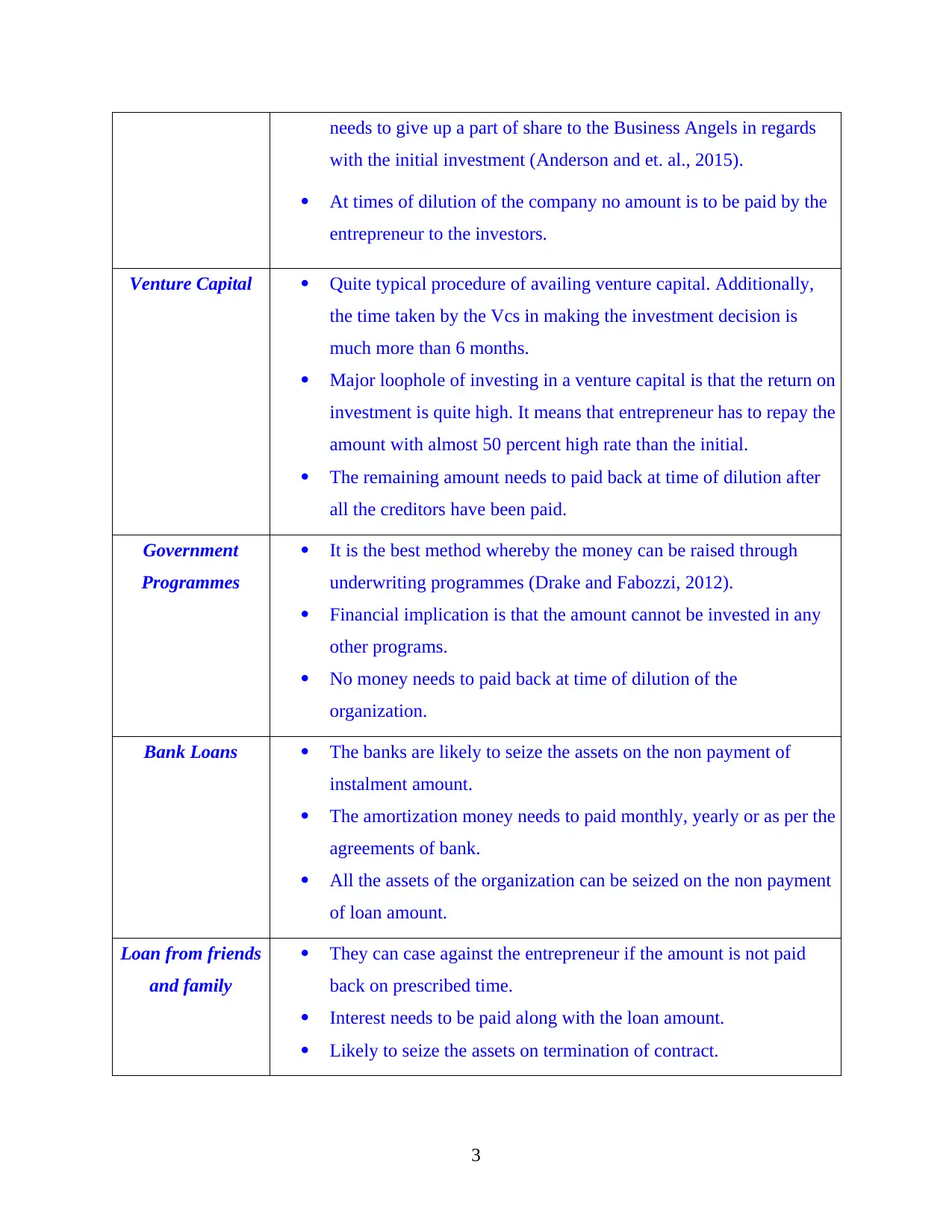
needs to give up a part of share to the Business Angels in regards
with the initial investment (Anderson and et. al., 2015).
At times of dilution of the company no amount is to be paid by the
entrepreneur to the investors.
Venture Capital Quite typical procedure of availing venture capital. Additionally,
the time taken by the Vcs in making the investment decision is
much more than 6 months.
Major loophole of investing in a venture capital is that the return on
investment is quite high. It means that entrepreneur has to repay the
amount with almost 50 percent high rate than the initial.
The remaining amount needs to paid back at time of dilution after
all the creditors have been paid.
Government
Programmes
It is the best method whereby the money can be raised through
underwriting programmes (Drake and Fabozzi, 2012).
Financial implication is that the amount cannot be invested in any
other programs.
No money needs to paid back at time of dilution of the
organization.
Bank Loans The banks are likely to seize the assets on the non payment of
instalment amount.
The amortization money needs to paid monthly, yearly or as per the
agreements of bank.
All the assets of the organization can be seized on the non payment
of loan amount.
Loan from friends
and family
They can case against the entrepreneur if the amount is not paid
back on prescribed time.
Interest needs to be paid along with the loan amount.
Likely to seize the assets on termination of contract.
3
with the initial investment (Anderson and et. al., 2015).
At times of dilution of the company no amount is to be paid by the
entrepreneur to the investors.
Venture Capital Quite typical procedure of availing venture capital. Additionally,
the time taken by the Vcs in making the investment decision is
much more than 6 months.
Major loophole of investing in a venture capital is that the return on
investment is quite high. It means that entrepreneur has to repay the
amount with almost 50 percent high rate than the initial.
The remaining amount needs to paid back at time of dilution after
all the creditors have been paid.
Government
Programmes
It is the best method whereby the money can be raised through
underwriting programmes (Drake and Fabozzi, 2012).
Financial implication is that the amount cannot be invested in any
other programs.
No money needs to paid back at time of dilution of the
organization.
Bank Loans The banks are likely to seize the assets on the non payment of
instalment amount.
The amortization money needs to paid monthly, yearly or as per the
agreements of bank.
All the assets of the organization can be seized on the non payment
of loan amount.
Loan from friends
and family
They can case against the entrepreneur if the amount is not paid
back on prescribed time.
Interest needs to be paid along with the loan amount.
Likely to seize the assets on termination of contract.
3
⊘ This is a preview!⊘
Do you want full access?
Subscribe today to unlock all pages.

Trusted by 1+ million students worldwide
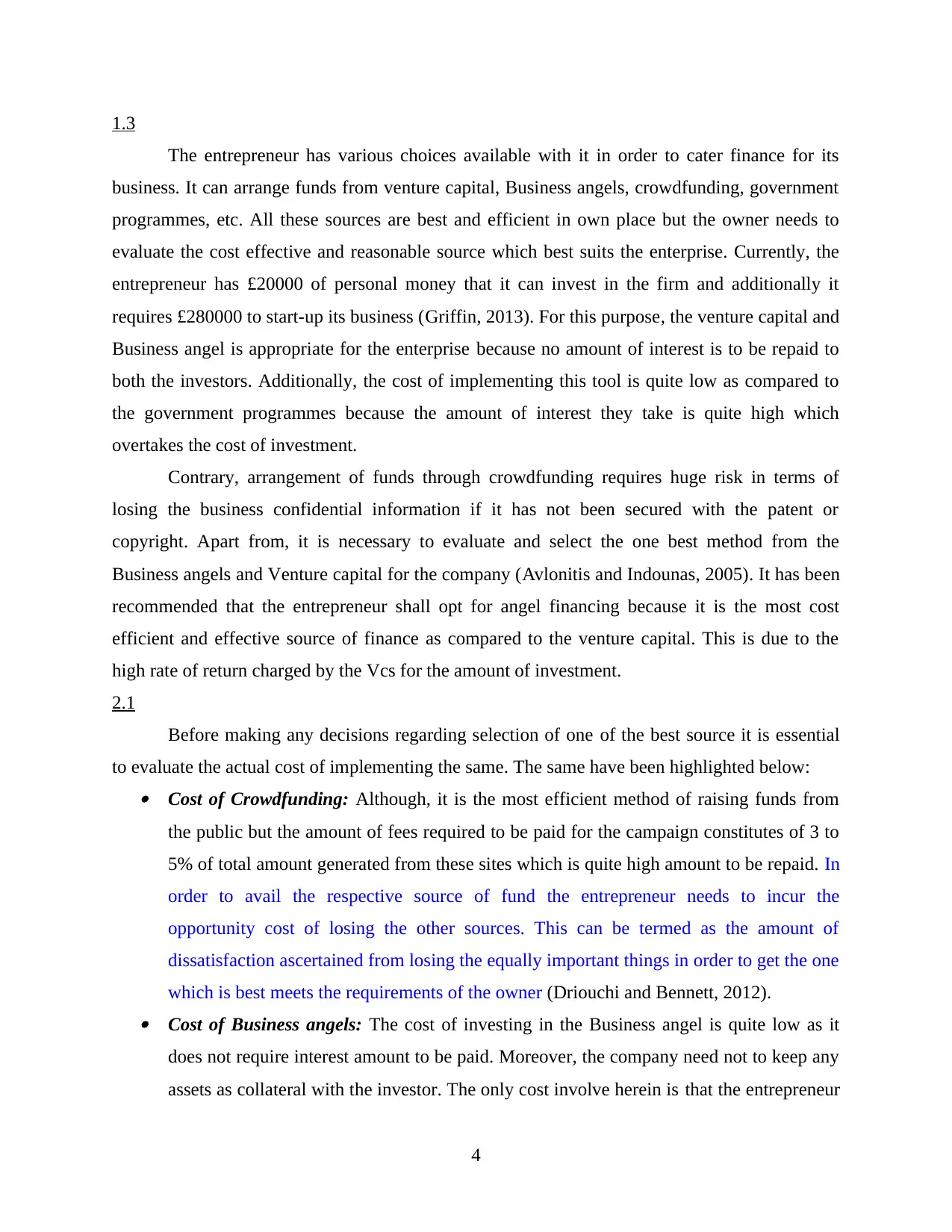
1.3
The entrepreneur has various choices available with it in order to cater finance for its
business. It can arrange funds from venture capital, Business angels, crowdfunding, government
programmes, etc. All these sources are best and efficient in own place but the owner needs to
evaluate the cost effective and reasonable source which best suits the enterprise. Currently, the
entrepreneur has £20000 of personal money that it can invest in the firm and additionally it
requires £280000 to start-up its business (Griffin, 2013). For this purpose, the venture capital and
Business angel is appropriate for the enterprise because no amount of interest is to be repaid to
both the investors. Additionally, the cost of implementing this tool is quite low as compared to
the government programmes because the amount of interest they take is quite high which
overtakes the cost of investment.
Contrary, arrangement of funds through crowdfunding requires huge risk in terms of
losing the business confidential information if it has not been secured with the patent or
copyright. Apart from, it is necessary to evaluate and select the one best method from the
Business angels and Venture capital for the company (Avlonitis and Indounas, 2005). It has been
recommended that the entrepreneur shall opt for angel financing because it is the most cost
efficient and effective source of finance as compared to the venture capital. This is due to the
high rate of return charged by the Vcs for the amount of investment.
2.1
Before making any decisions regarding selection of one of the best source it is essential
to evaluate the actual cost of implementing the same. The same have been highlighted below: Cost of Crowdfunding: Although, it is the most efficient method of raising funds from
the public but the amount of fees required to be paid for the campaign constitutes of 3 to
5% of total amount generated from these sites which is quite high amount to be repaid. In
order to avail the respective source of fund the entrepreneur needs to incur the
opportunity cost of losing the other sources. This can be termed as the amount of
dissatisfaction ascertained from losing the equally important things in order to get the one
which is best meets the requirements of the owner (Driouchi and Bennett, 2012). Cost of Business angels: The cost of investing in the Business angel is quite low as it
does not require interest amount to be paid. Moreover, the company need not to keep any
assets as collateral with the investor. The only cost involve herein is that the entrepreneur
4
The entrepreneur has various choices available with it in order to cater finance for its
business. It can arrange funds from venture capital, Business angels, crowdfunding, government
programmes, etc. All these sources are best and efficient in own place but the owner needs to
evaluate the cost effective and reasonable source which best suits the enterprise. Currently, the
entrepreneur has £20000 of personal money that it can invest in the firm and additionally it
requires £280000 to start-up its business (Griffin, 2013). For this purpose, the venture capital and
Business angel is appropriate for the enterprise because no amount of interest is to be repaid to
both the investors. Additionally, the cost of implementing this tool is quite low as compared to
the government programmes because the amount of interest they take is quite high which
overtakes the cost of investment.
Contrary, arrangement of funds through crowdfunding requires huge risk in terms of
losing the business confidential information if it has not been secured with the patent or
copyright. Apart from, it is necessary to evaluate and select the one best method from the
Business angels and Venture capital for the company (Avlonitis and Indounas, 2005). It has been
recommended that the entrepreneur shall opt for angel financing because it is the most cost
efficient and effective source of finance as compared to the venture capital. This is due to the
high rate of return charged by the Vcs for the amount of investment.
2.1
Before making any decisions regarding selection of one of the best source it is essential
to evaluate the actual cost of implementing the same. The same have been highlighted below: Cost of Crowdfunding: Although, it is the most efficient method of raising funds from
the public but the amount of fees required to be paid for the campaign constitutes of 3 to
5% of total amount generated from these sites which is quite high amount to be repaid. In
order to avail the respective source of fund the entrepreneur needs to incur the
opportunity cost of losing the other sources. This can be termed as the amount of
dissatisfaction ascertained from losing the equally important things in order to get the one
which is best meets the requirements of the owner (Driouchi and Bennett, 2012). Cost of Business angels: The cost of investing in the Business angel is quite low as it
does not require interest amount to be paid. Moreover, the company need not to keep any
assets as collateral with the investor. The only cost involve herein is that the entrepreneur
4
Paraphrase This Document
Need a fresh take? Get an instant paraphrase of this document with our AI Paraphraser
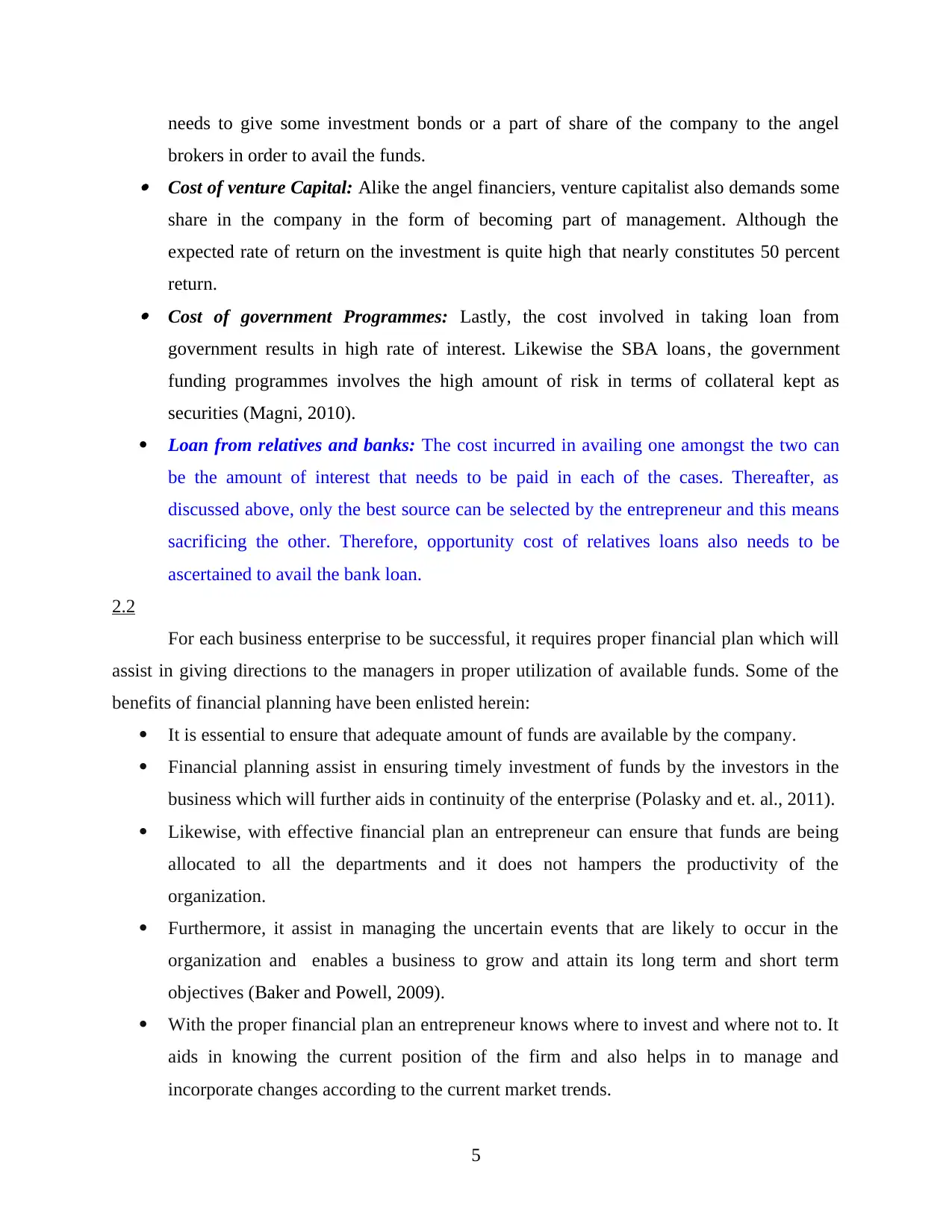
needs to give some investment bonds or a part of share of the company to the angel
brokers in order to avail the funds. Cost of venture Capital: Alike the angel financiers, venture capitalist also demands some
share in the company in the form of becoming part of management. Although the
expected rate of return on the investment is quite high that nearly constitutes 50 percent
return. Cost of government Programmes: Lastly, the cost involved in taking loan from
government results in high rate of interest. Likewise the SBA loans, the government
funding programmes involves the high amount of risk in terms of collateral kept as
securities (Magni, 2010).
Loan from relatives and banks: The cost incurred in availing one amongst the two can
be the amount of interest that needs to be paid in each of the cases. Thereafter, as
discussed above, only the best source can be selected by the entrepreneur and this means
sacrificing the other. Therefore, opportunity cost of relatives loans also needs to be
ascertained to avail the bank loan.
2.2
For each business enterprise to be successful, it requires proper financial plan which will
assist in giving directions to the managers in proper utilization of available funds. Some of the
benefits of financial planning have been enlisted herein:
It is essential to ensure that adequate amount of funds are available by the company.
Financial planning assist in ensuring timely investment of funds by the investors in the
business which will further aids in continuity of the enterprise (Polasky and et. al., 2011).
Likewise, with effective financial plan an entrepreneur can ensure that funds are being
allocated to all the departments and it does not hampers the productivity of the
organization.
Furthermore, it assist in managing the uncertain events that are likely to occur in the
organization and enables a business to grow and attain its long term and short term
objectives (Baker and Powell, 2009).
With the proper financial plan an entrepreneur knows where to invest and where not to. It
aids in knowing the current position of the firm and also helps in to manage and
incorporate changes according to the current market trends.
5
brokers in order to avail the funds. Cost of venture Capital: Alike the angel financiers, venture capitalist also demands some
share in the company in the form of becoming part of management. Although the
expected rate of return on the investment is quite high that nearly constitutes 50 percent
return. Cost of government Programmes: Lastly, the cost involved in taking loan from
government results in high rate of interest. Likewise the SBA loans, the government
funding programmes involves the high amount of risk in terms of collateral kept as
securities (Magni, 2010).
Loan from relatives and banks: The cost incurred in availing one amongst the two can
be the amount of interest that needs to be paid in each of the cases. Thereafter, as
discussed above, only the best source can be selected by the entrepreneur and this means
sacrificing the other. Therefore, opportunity cost of relatives loans also needs to be
ascertained to avail the bank loan.
2.2
For each business enterprise to be successful, it requires proper financial plan which will
assist in giving directions to the managers in proper utilization of available funds. Some of the
benefits of financial planning have been enlisted herein:
It is essential to ensure that adequate amount of funds are available by the company.
Financial planning assist in ensuring timely investment of funds by the investors in the
business which will further aids in continuity of the enterprise (Polasky and et. al., 2011).
Likewise, with effective financial plan an entrepreneur can ensure that funds are being
allocated to all the departments and it does not hampers the productivity of the
organization.
Furthermore, it assist in managing the uncertain events that are likely to occur in the
organization and enables a business to grow and attain its long term and short term
objectives (Baker and Powell, 2009).
With the proper financial plan an entrepreneur knows where to invest and where not to. It
aids in knowing the current position of the firm and also helps in to manage and
incorporate changes according to the current market trends.
5
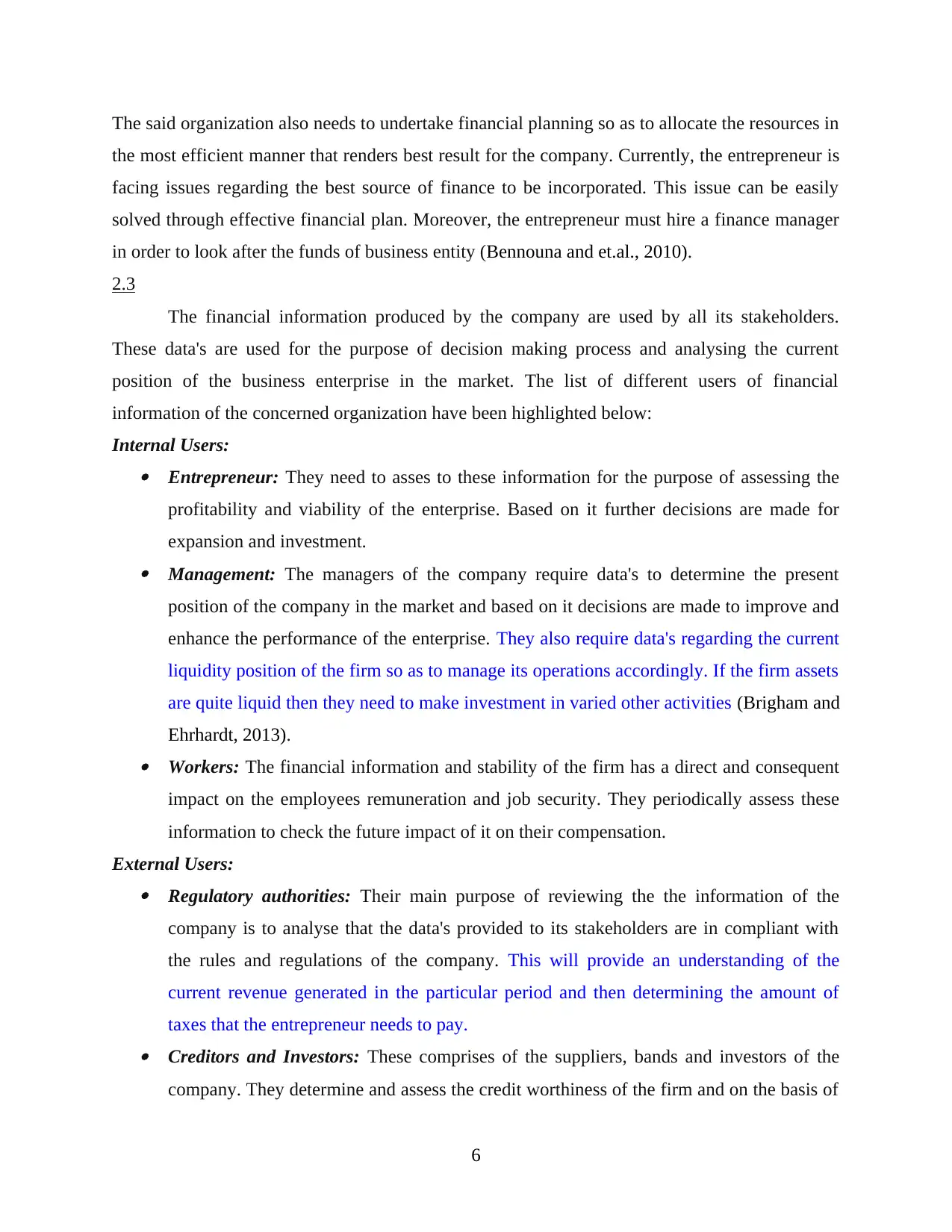
The said organization also needs to undertake financial planning so as to allocate the resources in
the most efficient manner that renders best result for the company. Currently, the entrepreneur is
facing issues regarding the best source of finance to be incorporated. This issue can be easily
solved through effective financial plan. Moreover, the entrepreneur must hire a finance manager
in order to look after the funds of business entity (Bennouna and et.al., 2010).
2.3
The financial information produced by the company are used by all its stakeholders.
These data's are used for the purpose of decision making process and analysing the current
position of the business enterprise in the market. The list of different users of financial
information of the concerned organization have been highlighted below:
Internal Users: Entrepreneur: They need to asses to these information for the purpose of assessing the
profitability and viability of the enterprise. Based on it further decisions are made for
expansion and investment. Management: The managers of the company require data's to determine the present
position of the company in the market and based on it decisions are made to improve and
enhance the performance of the enterprise. They also require data's regarding the current
liquidity position of the firm so as to manage its operations accordingly. If the firm assets
are quite liquid then they need to make investment in varied other activities (Brigham and
Ehrhardt, 2013). Workers: The financial information and stability of the firm has a direct and consequent
impact on the employees remuneration and job security. They periodically assess these
information to check the future impact of it on their compensation.
External Users: Regulatory authorities: Their main purpose of reviewing the the information of the
company is to analyse that the data's provided to its stakeholders are in compliant with
the rules and regulations of the company. This will provide an understanding of the
current revenue generated in the particular period and then determining the amount of
taxes that the entrepreneur needs to pay. Creditors and Investors: These comprises of the suppliers, bands and investors of the
company. They determine and assess the credit worthiness of the firm and on the basis of
6
the most efficient manner that renders best result for the company. Currently, the entrepreneur is
facing issues regarding the best source of finance to be incorporated. This issue can be easily
solved through effective financial plan. Moreover, the entrepreneur must hire a finance manager
in order to look after the funds of business entity (Bennouna and et.al., 2010).
2.3
The financial information produced by the company are used by all its stakeholders.
These data's are used for the purpose of decision making process and analysing the current
position of the business enterprise in the market. The list of different users of financial
information of the concerned organization have been highlighted below:
Internal Users: Entrepreneur: They need to asses to these information for the purpose of assessing the
profitability and viability of the enterprise. Based on it further decisions are made for
expansion and investment. Management: The managers of the company require data's to determine the present
position of the company in the market and based on it decisions are made to improve and
enhance the performance of the enterprise. They also require data's regarding the current
liquidity position of the firm so as to manage its operations accordingly. If the firm assets
are quite liquid then they need to make investment in varied other activities (Brigham and
Ehrhardt, 2013). Workers: The financial information and stability of the firm has a direct and consequent
impact on the employees remuneration and job security. They periodically assess these
information to check the future impact of it on their compensation.
External Users: Regulatory authorities: Their main purpose of reviewing the the information of the
company is to analyse that the data's provided to its stakeholders are in compliant with
the rules and regulations of the company. This will provide an understanding of the
current revenue generated in the particular period and then determining the amount of
taxes that the entrepreneur needs to pay. Creditors and Investors: These comprises of the suppliers, bands and investors of the
company. They determine and assess the credit worthiness of the firm and on the basis of
6
⊘ This is a preview!⊘
Do you want full access?
Subscribe today to unlock all pages.

Trusted by 1+ million students worldwide
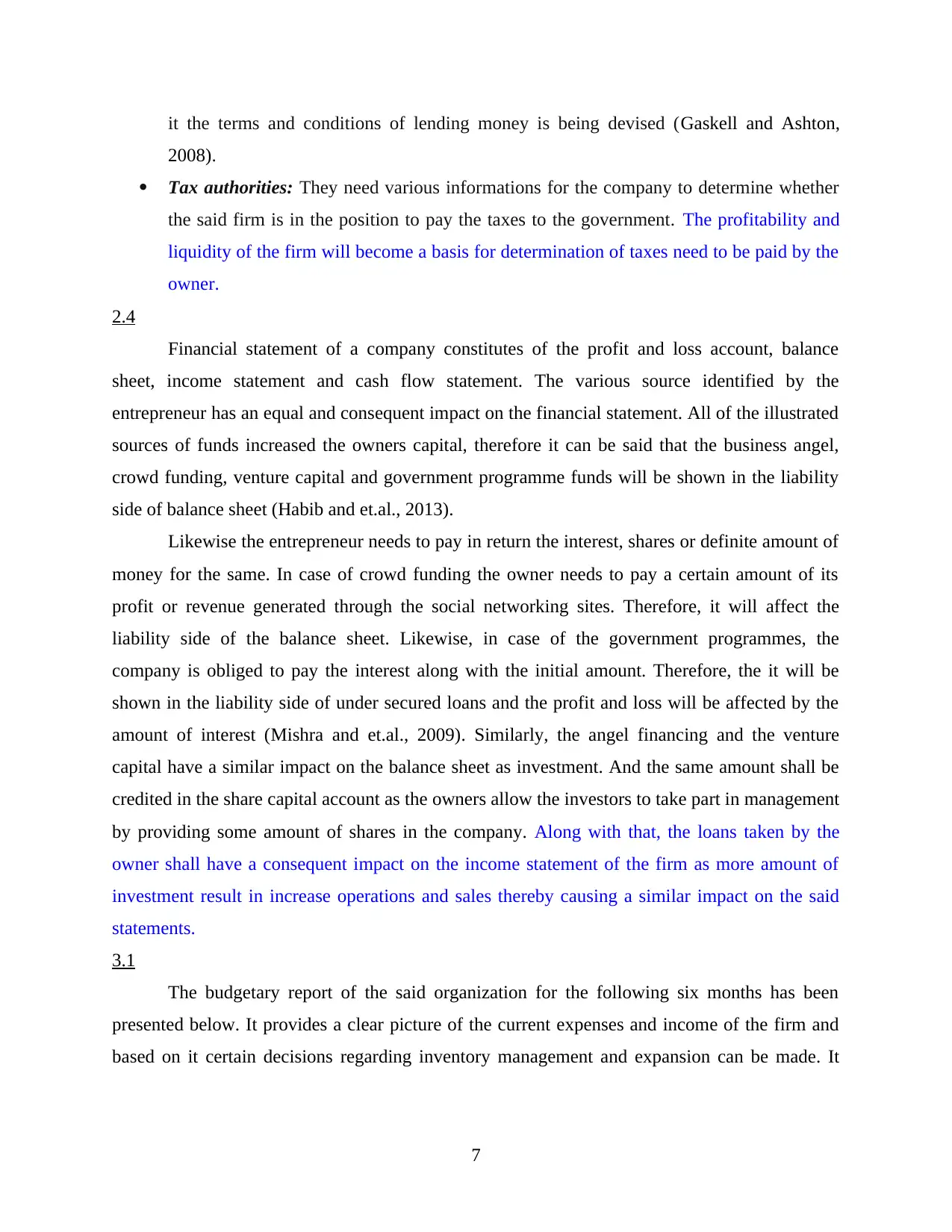
it the terms and conditions of lending money is being devised (Gaskell and Ashton,
2008).
Tax authorities: They need various informations for the company to determine whether
the said firm is in the position to pay the taxes to the government. The profitability and
liquidity of the firm will become a basis for determination of taxes need to be paid by the
owner.
2.4
Financial statement of a company constitutes of the profit and loss account, balance
sheet, income statement and cash flow statement. The various source identified by the
entrepreneur has an equal and consequent impact on the financial statement. All of the illustrated
sources of funds increased the owners capital, therefore it can be said that the business angel,
crowd funding, venture capital and government programme funds will be shown in the liability
side of balance sheet (Habib and et.al., 2013).
Likewise the entrepreneur needs to pay in return the interest, shares or definite amount of
money for the same. In case of crowd funding the owner needs to pay a certain amount of its
profit or revenue generated through the social networking sites. Therefore, it will affect the
liability side of the balance sheet. Likewise, in case of the government programmes, the
company is obliged to pay the interest along with the initial amount. Therefore, the it will be
shown in the liability side of under secured loans and the profit and loss will be affected by the
amount of interest (Mishra and et.al., 2009). Similarly, the angel financing and the venture
capital have a similar impact on the balance sheet as investment. And the same amount shall be
credited in the share capital account as the owners allow the investors to take part in management
by providing some amount of shares in the company. Along with that, the loans taken by the
owner shall have a consequent impact on the income statement of the firm as more amount of
investment result in increase operations and sales thereby causing a similar impact on the said
statements.
3.1
The budgetary report of the said organization for the following six months has been
presented below. It provides a clear picture of the current expenses and income of the firm and
based on it certain decisions regarding inventory management and expansion can be made. It
7
2008).
Tax authorities: They need various informations for the company to determine whether
the said firm is in the position to pay the taxes to the government. The profitability and
liquidity of the firm will become a basis for determination of taxes need to be paid by the
owner.
2.4
Financial statement of a company constitutes of the profit and loss account, balance
sheet, income statement and cash flow statement. The various source identified by the
entrepreneur has an equal and consequent impact on the financial statement. All of the illustrated
sources of funds increased the owners capital, therefore it can be said that the business angel,
crowd funding, venture capital and government programme funds will be shown in the liability
side of balance sheet (Habib and et.al., 2013).
Likewise the entrepreneur needs to pay in return the interest, shares or definite amount of
money for the same. In case of crowd funding the owner needs to pay a certain amount of its
profit or revenue generated through the social networking sites. Therefore, it will affect the
liability side of the balance sheet. Likewise, in case of the government programmes, the
company is obliged to pay the interest along with the initial amount. Therefore, the it will be
shown in the liability side of under secured loans and the profit and loss will be affected by the
amount of interest (Mishra and et.al., 2009). Similarly, the angel financing and the venture
capital have a similar impact on the balance sheet as investment. And the same amount shall be
credited in the share capital account as the owners allow the investors to take part in management
by providing some amount of shares in the company. Along with that, the loans taken by the
owner shall have a consequent impact on the income statement of the firm as more amount of
investment result in increase operations and sales thereby causing a similar impact on the said
statements.
3.1
The budgetary report of the said organization for the following six months has been
presented below. It provides a clear picture of the current expenses and income of the firm and
based on it certain decisions regarding inventory management and expansion can be made. It
7
Paraphrase This Document
Need a fresh take? Get an instant paraphrase of this document with our AI Paraphraser
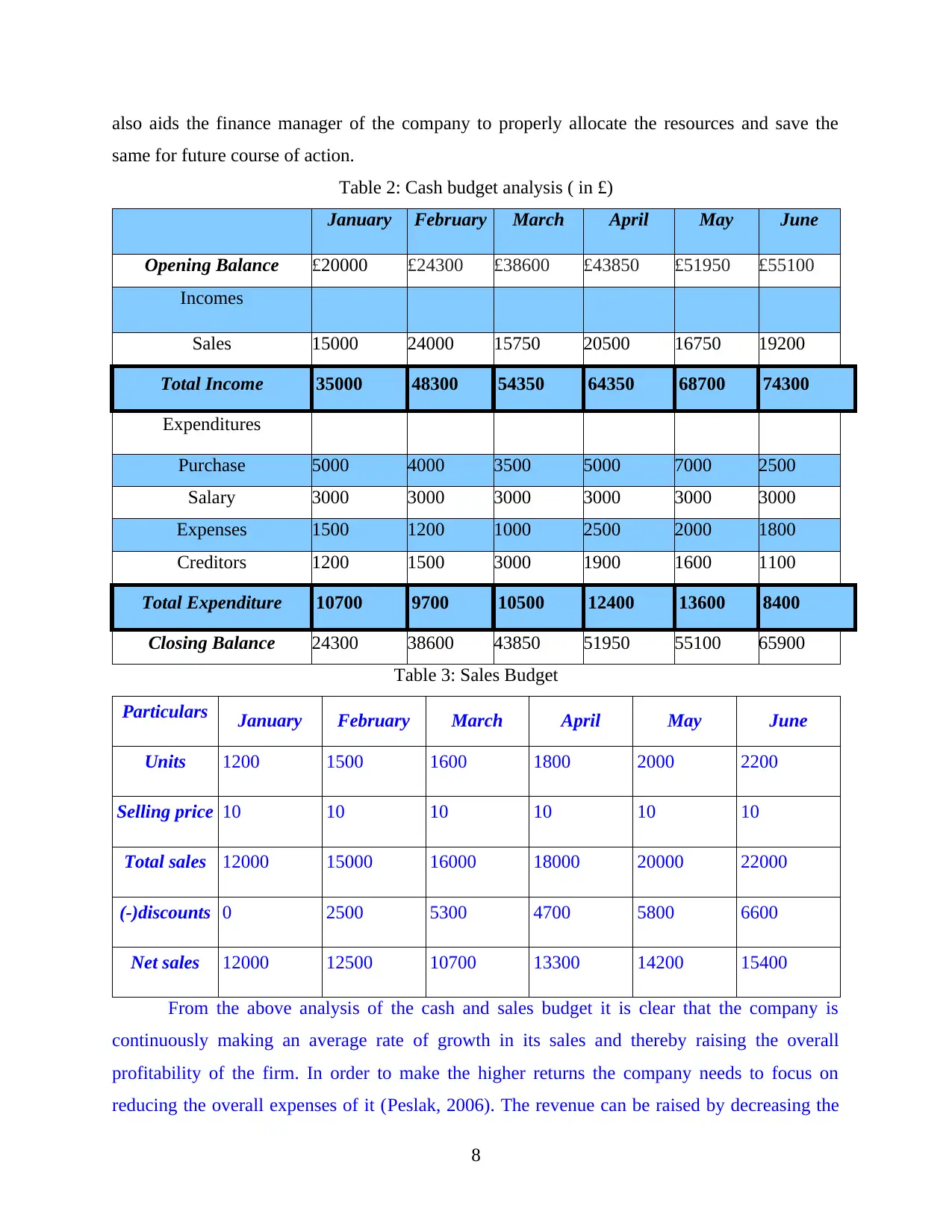
also aids the finance manager of the company to properly allocate the resources and save the
same for future course of action.
Table 2: Cash budget analysis ( in £)
January February March April May June
Opening Balance £20000 £24300 £38600 £43850 £51950 £55100
Incomes
Sales 15000 24000 15750 20500 16750 19200
Total Income 35000 48300 54350 64350 68700 74300
Expenditures
Purchase 5000 4000 3500 5000 7000 2500
Salary 3000 3000 3000 3000 3000 3000
Expenses 1500 1200 1000 2500 2000 1800
Creditors 1200 1500 3000 1900 1600 1100
Total Expenditure 10700 9700 10500 12400 13600 8400
Closing Balance 24300 38600 43850 51950 55100 65900
Table 3: Sales Budget
Particulars January February March April May June
Units 1200 1500 1600 1800 2000 2200
Selling price 10 10 10 10 10 10
Total sales 12000 15000 16000 18000 20000 22000
(-)discounts 0 2500 5300 4700 5800 6600
Net sales 12000 12500 10700 13300 14200 15400
From the above analysis of the cash and sales budget it is clear that the company is
continuously making an average rate of growth in its sales and thereby raising the overall
profitability of the firm. In order to make the higher returns the company needs to focus on
reducing the overall expenses of it (Peslak, 2006). The revenue can be raised by decreasing the
8
same for future course of action.
Table 2: Cash budget analysis ( in £)
January February March April May June
Opening Balance £20000 £24300 £38600 £43850 £51950 £55100
Incomes
Sales 15000 24000 15750 20500 16750 19200
Total Income 35000 48300 54350 64350 68700 74300
Expenditures
Purchase 5000 4000 3500 5000 7000 2500
Salary 3000 3000 3000 3000 3000 3000
Expenses 1500 1200 1000 2500 2000 1800
Creditors 1200 1500 3000 1900 1600 1100
Total Expenditure 10700 9700 10500 12400 13600 8400
Closing Balance 24300 38600 43850 51950 55100 65900
Table 3: Sales Budget
Particulars January February March April May June
Units 1200 1500 1600 1800 2000 2200
Selling price 10 10 10 10 10 10
Total sales 12000 15000 16000 18000 20000 22000
(-)discounts 0 2500 5300 4700 5800 6600
Net sales 12000 12500 10700 13300 14200 15400
From the above analysis of the cash and sales budget it is clear that the company is
continuously making an average rate of growth in its sales and thereby raising the overall
profitability of the firm. In order to make the higher returns the company needs to focus on
reducing the overall expenses of it (Peslak, 2006). The revenue can be raised by decreasing the
8
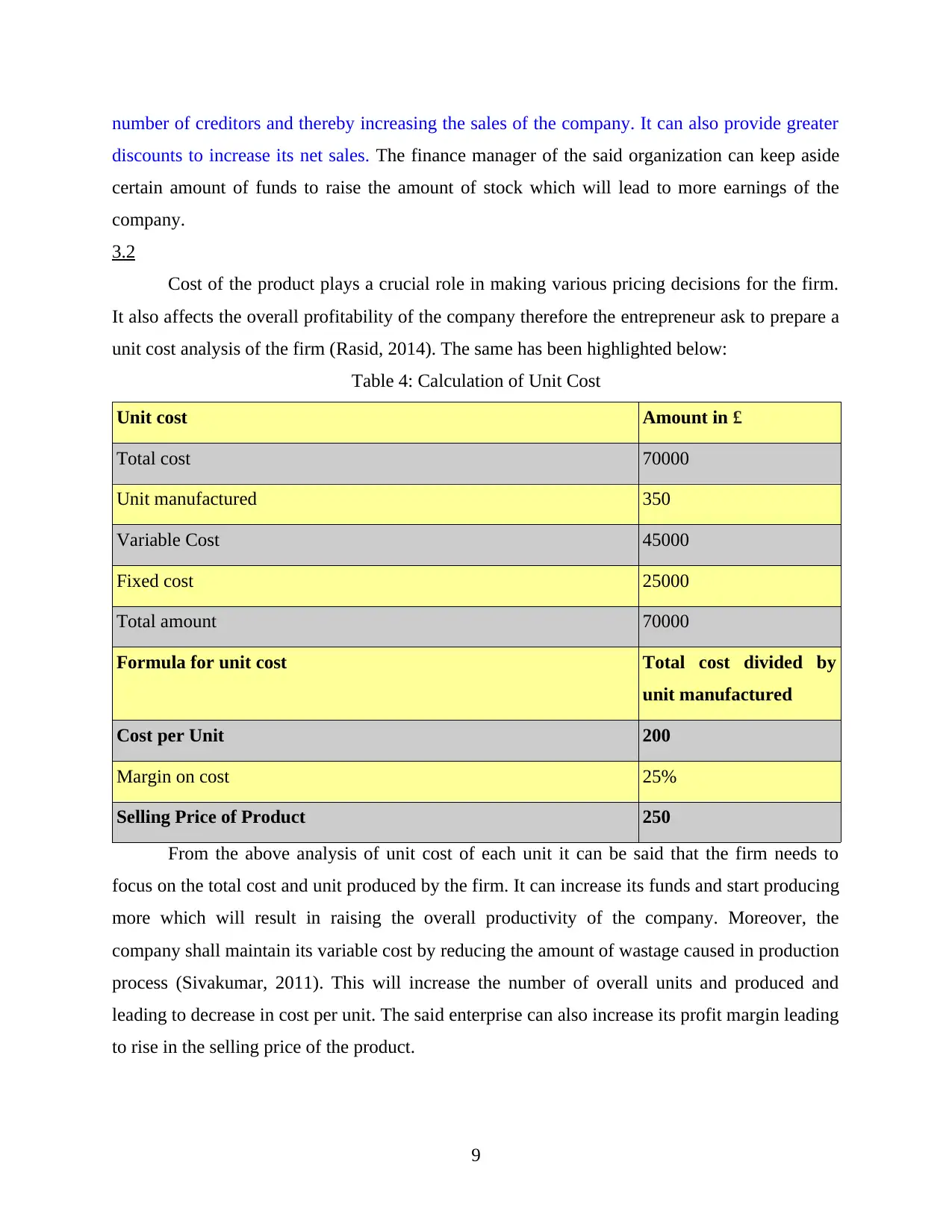
number of creditors and thereby increasing the sales of the company. It can also provide greater
discounts to increase its net sales. The finance manager of the said organization can keep aside
certain amount of funds to raise the amount of stock which will lead to more earnings of the
company.
3.2
Cost of the product plays a crucial role in making various pricing decisions for the firm.
It also affects the overall profitability of the company therefore the entrepreneur ask to prepare a
unit cost analysis of the firm (Rasid, 2014). The same has been highlighted below:
Table 4: Calculation of Unit Cost
Unit cost Amount in £
Total cost 70000
Unit manufactured 350
Variable Cost 45000
Fixed cost 25000
Total amount 70000
Formula for unit cost Total cost divided by
unit manufactured
Cost per Unit 200
Margin on cost 25%
Selling Price of Product 250
From the above analysis of unit cost of each unit it can be said that the firm needs to
focus on the total cost and unit produced by the firm. It can increase its funds and start producing
more which will result in raising the overall productivity of the company. Moreover, the
company shall maintain its variable cost by reducing the amount of wastage caused in production
process (Sivakumar, 2011). This will increase the number of overall units and produced and
leading to decrease in cost per unit. The said enterprise can also increase its profit margin leading
to rise in the selling price of the product.
9
discounts to increase its net sales. The finance manager of the said organization can keep aside
certain amount of funds to raise the amount of stock which will lead to more earnings of the
company.
3.2
Cost of the product plays a crucial role in making various pricing decisions for the firm.
It also affects the overall profitability of the company therefore the entrepreneur ask to prepare a
unit cost analysis of the firm (Rasid, 2014). The same has been highlighted below:
Table 4: Calculation of Unit Cost
Unit cost Amount in £
Total cost 70000
Unit manufactured 350
Variable Cost 45000
Fixed cost 25000
Total amount 70000
Formula for unit cost Total cost divided by
unit manufactured
Cost per Unit 200
Margin on cost 25%
Selling Price of Product 250
From the above analysis of unit cost of each unit it can be said that the firm needs to
focus on the total cost and unit produced by the firm. It can increase its funds and start producing
more which will result in raising the overall productivity of the company. Moreover, the
company shall maintain its variable cost by reducing the amount of wastage caused in production
process (Sivakumar, 2011). This will increase the number of overall units and produced and
leading to decrease in cost per unit. The said enterprise can also increase its profit margin leading
to rise in the selling price of the product.
9
⊘ This is a preview!⊘
Do you want full access?
Subscribe today to unlock all pages.

Trusted by 1+ million students worldwide
1 out of 19
Related Documents
Your All-in-One AI-Powered Toolkit for Academic Success.
+13062052269
info@desklib.com
Available 24*7 on WhatsApp / Email
![[object Object]](/_next/static/media/star-bottom.7253800d.svg)
Unlock your academic potential
Copyright © 2020–2025 A2Z Services. All Rights Reserved. Developed and managed by ZUCOL.





